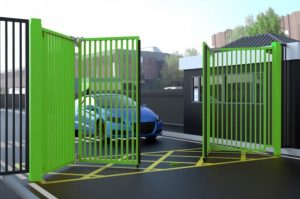Automatic Gates Comply Safety Standards from HSE & DHF
22nd December 2014

All Procter automatic gates comply with gate safety standards and guidance
Automatic gates are large and heavy, so they require powerful motors to drive the gate leaves. Provided adequate safeguards are in place, automatic gates are safe for users and others in the vicinity. However, as has been demonstrated in several recent tragic accidents, gates that have not been designed, manufactured and installed in accordance with current standards and official guidance have the potential to cause serious injuries or even death.
For many years the key British Standard for automatic gates has been BS EN 12453:2001 (Industrial, commercial and garage doors and gates. Safety in use of power operated doors. Requirements), but investigations by the HSE (Health and Safety Executive) following accidents involving gates led to the HSE issuing new guidance and stating that in some cases gate manufacturers should use additional safeguarding techniques beyond those laid down in the standard in order to reduce the likelihood of hazardous situations arising.
Today, BS EN 12453:2001 is still current, though a revised version is being prepared. The HSE has issued a series of safety notices (FOD WSW 1-2010 in February 2010; FOD 7-2010 in September 2010; and OPSTD 1-2011 in January 2011), as well as some FAQs (frequently asked questions), and advice for gate manufacturers (WG-2013.08) relating to drawing-in risks that can occur if children attempt to ride on powered sliding gates. The Powered Gate Group of the DHF (Door and Hardware Federation) has also published a booklet titled Guide to Gate Safety Legislation and Standards, which was prepared in consultation with the HSE, and has subsequently issued a safety bulletin relating to telescopic sliding gates.
In addition, Procter Automatic Gates has published its own powered gate FAQs to expand on those from the HSE, plus a White Paper on Automatic Sliding Gate Safety and an Automatic Gate Risk Assessment Calculator. More recently the company has launched a free Automatic Gate Specification Checking Service for architects and specifiers.
In October 2014 the Powered Gate Group of the Door and Hardware Federation organised the first Gate Safety Week, which was very actively supported by Procter Automatic Gates, other gate manufacturers, the HSE and a number of trade associations and health and safety organisations.
Procter Automatic Gates takes the issue of gate safety extremely seriously, being one of the founding members of the Powered Gate Group of the DHF. The company designs its own gates (or checks thoroughly any designs received from architects) so is able to ensure that all necessary safeguards are built-in, which is far more cost-effective than retrofitting safety measures after a gate has been installed. Furthermore, the company has its own teams of experienced and knowledgeable installers, and all of its automated gate installations are approved by Procter personnel who have attended the two-day Powered Gate Group training course and been awarded their diploma – these personnel all hold a photo I/D card confirming their Safety Assured Installer accreditation. By ensuring that the gates are all designed, manufactured and installed correctly, Procter Automatic Gates is able to CE mark its gates in accordance with the requirements of the Machinery Directive 2006/42/EC. Furthermore, gates are supplied with operator training, operating manuals and a maintenance contract where requested.
Whether you need powered sliding gates, swing gates, bi-folding gates or telescopic gates, purchasing from Procter Automatic Gates will guarantee that your gate complies fully with the current British Standard, the Essential Health and Safety Requirements of the Machinery Directive, and the official guidance from the HSE and Powered Gate Group of the DHF.
To discuss any aspects of powered gates, contact Procter Contracts by email [email protected]
